Abstract
In 21st-century American cities, urban crime remains a critical public safety concern influenced by complex social, political, and environmental structures. Crime is not randomly distributed and built-environment characteristics, such as street network configuration, impact criminal activity through spatial dependence effects at multiple scales. This study investigates the cross-sectional, multi-scale spatial effects of street network configuration on property crime across neighborhoods in Charlotte, North Carolina. Specifically, we examine whether the fundamental characteristics of a neighborhood’s street network contribute to variations in its property crime. Using a novel and granular spatial approach, incorporating spatial econometric models (SAR, CAR, and GWR), several street network characteristics, including density, connectivity, and centrality, within five nested buffer bands are measured to capture both local and non-local influences. The results provide strong and consistent evidence that certain characteristics of the neighborhood street network, such as connectivity and accessibility, significantly influence the occurrence of property crime. Impacts are also found to be spatially heterogenous, manifesting themselves at the mid-range scale rather than hyper-locally. The integration of comprehensive measures of street network configuration into spatially explicit models offers new opportunities for advancement in environmental criminology literature. Such spatial dynamics further contribute to urban safety policy by informing decision-makers so that they can ensure a defensively built environment design.
1. Introduction
Urban crime is a serious public safety concern and the increasing rate of urbanization has heightened the crime problem in urban areas [1,2]. Cities cannot aspire to reach social sustainability goals without considering their citizens’ security concerns [3].
Criminal opportunity theories argue that physical environments create distinctive criminal opportunities and circumstances that are particularly conducive to balancing the demand and supply of criminal acts [4,5]. Considering that crime is not randomly distributed, it is well established that the characteristics of built environments can change opportunities for criminal acts and influence the offenders’ spatial decision-making process [6]. Also, as pointed out by [7], while traveling to reach potential targets, offenders follow streets as pathways for these movements. As key elements of built environment design, street layouts can be envisioned as interconnected webs of nodes and paths that structure both offenders’ and counter-offenders’ decision-making. This makes them a crucial factor for understanding crime and for devising crime prevention strategies and practices [8].
Neglecting the relationship between urban design and crime in the urban planning process can elevate crime rates. Conversely, the characteristics of a well-designed street network can deter crime by altering the physical environment and influencing human mobility patterns [9,10]. For instance, crime pattern theory suggests that offenders are more likely to commit crimes in well-traveled areas, which are often characterized by highly connected and accessible street segments [11]. In this sense, quantifying the relationship between the configuration of urban street networks and crime provides critical insights into crime prevention, thus leading to informed policies on defensible built-environment designs, influencing urban livability and safety [12].
Within the domain of environmental criminology, significant gaps exist in the literature on the relationship between street network configuration and crime. While the properties of street network configurations have been analyzed extensively, the understanding of their various impacts on crime remains inconsistent and incomplete. Furthermore, much of the research in this area is not rooted in robust, data-driven empirical analysis, leaving critical patterns inadequately understood. Most crime events are place-based and collectively create complex and nuanced spatial mosaics of interaction [12], yet these multi-scale effects are insufficiently integrated with street network studies. Moreover, few studies have included a comprehensive view of neighborhoods’ socio-spatial characteristics when examining the impact of street networks on crime. Utilizing a robust multi-scale spatial approach, this study conducts a multivariate statistical modeling of the relationship between street network characteristics and property crime, considering the spatial dependence and spatial heterogeneity effects of the detailed socio-spatial characteristics and street network measures of neighborhoods. In this sense, this research aims to address how the multifaceted configuration of street networks in the City of Charlotte’s (North Carolina) neighborhoods affects, directly and through spatial effects, the distribution of property crime. This question is particularly significant given the persistent concern about crime in the city of Charlotte, where our empirical study is set. Addressing this issue supports local decision makers and practitioners in gaining insight into the effectiveness of street network designs in reducing crime.
The rest of the paper is organized as follows. In Section 2, a review of the relevant literature on the emergence of built environment perspectives in criminology is presented. We specifically address the understanding of the role of street network configurations in crime, following both theoretical and empirical frameworks, and we identify critical knowledge gaps in this respect. The empirical study area of this research and an overview of its crime status are presented in Section 3. This is followed by a presentation of the elements of our research design, including data collection and preparation, along with an overview of the modeling strategies used to capture the relationship between street network configuration and property crime. In Section 4, the data processing results, and core findings of the spatial models are provided, offering insights into the effects of street network structures on criminal activity. Section 5 discusses the findings, positioning them in relation to prior work in the field, highlighting the validity, challenges, and extension of the current understanding. Finally, Section 6 concludes the study and outlines future research directions.
2. Literature Review
2.1. Theoretical Framework
Throughout history, there has been a strong sense of a relationship between built environment design and crime. Ancient civilizations utilized natural formations, walls, and linear urban layouts as protective measures [13]. In medieval times, England moved to view road design as a crime control measure, as part of the broader Statute of Winchester of 1285 [14,15]. During the Renaissance, security became intertwined with urban design and city governance, and emphasized blending functionality with safety [13].
In Western countries, the 19th century saw a purposeful approach to urban crime eradication and prevention through strategic thoroughfare development in slum and crime-ridden areas. In London, for instance, streets such as Victoria Street and New Oxford Street were constructed to dismantle criminal “rookeries” [16,17]. In the 20th century, research on urban crime shifted towards political and social themes, with a strong emphasis on social agency. While social justice, individual freedom and cognition, and collective security gained prominence, physical space was seen as a vehicle capable of influencing human behavior [18]. Statistical studies of crime also emerged during this period, tracing their origins to earlier work by André-Michel Guerry and Adolphe Quetelet, who mapped crime distribution in select European cities employing census data. This work established the relevance of places and spaces in crime activities and set the foundations of scientific crime analysis [19].
In the United States, the understanding of environmental factors of crime in the literature appeared in the 1920s with the introduction of social disorganization theory, indicating that neighborhood-level characteristics such as poverty, residential mobility, and ethnicity affect crime [20,21,22,23,24,25]. In the 1970s, the environmental approach to urban security emerged, emphasizing the use of urban design and situational factors to address crime [26]. Opportunity theories primarily shape the role of environmental factors in crime patterns, suggesting the need for solutions that both increase the perceived odds of apprehension and reduce the potential rewards of criminal activity. Jane Jacobs proposed principles for safer streets, such as clear public–private space distinctions, informal surveillance, and mixed-use neighborhoods fostering “eyes on the street” practices [1]. Oscar Newman’s Defensible Space theory countered this by arguing that high foot traffic by outsiders actually increases crime; territoriality and defined boundaries were advocated as more effective strategies [5,27]. These ideas influenced the development of Crime Prevention Through Environmental Design (CPTED) which aimed to modify the physical environment to reduce crime while fostering positive behaviors [1].
Building on existing foundational theories, several other theories have been introduced in the literature to model the interaction between built environments and crime. For instance, Situational Crime Prevention (SCP), proposed by [28], assumes the rational decision of offenders leads them to commit crimes when the cost is low. It seeks to design built environments in ways that reduce the rewards and increase the risk for offenders. Routine Activity Theory (RAT) posited that the convergence of three elements—motivated offenders, suitable targets, and the absence of capable guardians—is necessary for a direct-contact crime to occur [29]. For instance, visible signs of disorder, such as broken windows, signal tolerance for deviance, and hence attract offenders, as indicated in the Broken Windows Theory (BWT) [30]. Additionally, Ref. [5] built on the RAT to develop the Crime Pattern Theory (CPT) with significant geospatial insights and, on this basis, framed how offenders’ routine movements and awareness spaces influence crime distribution.
The subsequent literature has also emphasized the importance of crime location. The emergence of place-based criminology, particularly the ‘criminology of place’ perspective, highlights the value of examining crime at micro-geographic scales, such as individual street segments, to gain deeper insights into spatial crime patterns.
2.2. Empirical Studies on Street Network Configuration and Crime Analysis
As a fundamental component of the built environment and the primary substrate for routine human activities, street networks can play a crucial role in environmental criminology. They influence offenders’ choices regarding movement patterns and target selection [31] and determine their cognitive perception and knowledge of the environment, such as their familiarity with specific areas of a city, and thus affect the opportunities for crime [8,32]. The street network also dictates the movement and presence of general citizenry as capable guardians [11,33].
Early research on the relationship between street networks and crime dates to Chicago School sociologists who defined proximity to business streets as a significant factor in youth delinquency. The empirical evidence highlights a mixed direction between the characteristics of street networks and the occurrence of crime. Numerous studies indicate that a highly accessible, less complex street network with significant traffic or pedestrian flow, combined with the presence of appealing targets such as apartments, bars, or hotels/motels, tends to increase property crime [5,8,11,32,34,35,36,37,38,39,40,41]. Nonetheless, other studies such as [42,43] argue the opposite, with counterevidence indicating that grid networks are associated with lower property crime density compared to cul-de-sac networks as they promote visibility and accessibility. In this context, Refs. [4,44] also suggest that areas with higher street density and connectivity contribute to lower rates of burglary and auto theft. Some studies also suggest that the centrality of a location within the street network impacts crime. For instance, Refs. [36,38] indicate that street segments with higher betweenness centrality had higher burglary rates, because offenders enjoy better accessibility.
Studies of the street network effect on crime have used models that range from area-level analysis to street segment-level analysis. Building upon the macro-level perspectives in environmental criminology, Ref. [45] conceptualized and operationalized permeability across a metropolitan area, emphasizing the significance of municipality-level physical environments in inducing crime patterns. Refs. [8,32,40] pursued area-level analysis and Ref. [41] measured street density within census tracts or neighborhoods. On other hand, recent studies highlight that crime incidents are disproportionately distributed at a small subset of micro-places [8,46]. Public perceptions of unsafety are found to cluster in such micro-locations [47], underlining the critical importance of spatial resolution in crime analysis. Also, Ref. [48] indicates that corner properties, underlit pathways, or disconnected streets may act as attractors due to poor visibility and low foot traffic. A particular challenge when studying street networks concerns how to measure their structural properties in a way that reflects their use, their variability across the urban environment, and their lack of granularity, which can all be factors affecting the level of crime in each local area [31,42]. Various approaches have been proposed in this respect. Ref. [40] utilized an easy-to-compute measure of internal street access to each tract (ratio of street segments to number of intersection nodes within an area). Along the same idea, Ref. [32] developed an interval measure of street accessibility based on the number of turns into each street segment. Ref. [42] differentiated four types of street networks (grid-like, dendritic (branching), modified grid, and cul-de-sac) and compared crime rates across them. Looking at the relationship between neighborhoods, Ref. [41] defined the permeability of each neighborhood to its surroundings as the number of access streets (connectors) from major roadways (arterial streets). Another way to characterize how neighborhoods relate to one another on the street network is through their betweenness. Once measured, this localized index of network structure can be evaluated in terms of its impact on crime; Refs. [8,11,36] concluded that it is positively associated with crime. Some studies have also focused on the urban design construct of space syntax as a mathematical approach to quantify street network characteristics. Space syntax measures how each network component formed of perceptual collections of street segments connects to others, with key metrics including integration (how easily a street can be reached from other streets), connectivity (the number of direct connections a street has), and choice (the likelihood that a street will be used as part of a route between other streets) [8].
As covariates of crime, accounting for socio-spatial characteristics in modeling the influence of street networks on crime is a crucial aspect of environmental criminology. Ref. [49] suggested that the core tenets of social disorganization theory apply to crime dynamics. They emphasized that crime is not evenly distributed, but that it is instead concentrated in specific localized areas due to the unique mix of structural and social characteristics that prevail in these areas. Controlling for socio-spatial factors in modeling a relationship between street network and crime, Ref. [8] underscored the critical role of factors such as socioeconomic disadvantages in shaping crime patterns at the street segment level, particularly regarding how these factors interact with physical environmental features. They concluded that the influence of street network configuration on crime is intensified in disadvantaged areas due to weakened social cohesion and control. In a macro-level comprehensive analysis of crime predictors, Ref. [50] highlighted that s of “concentrated disadvantage”, such as poverty, ethnicity, and family disruption, were found to be robust predictors of crime. Similarly, Ref. [51] emphasized the role of structural disadvantage in the occurrence of crime, finding a significant effect of socio-demographic factors such as low literacy rates, high population density, and the prevalence of makeshift housing on vulnerability to street robberies.
The effect of other key built-environment elements, such as the morphology of buildings, is also widely addressed in the empirical built-environmental criminology literature. For instance, Ref. [52] indicates that areas with high-density residential land use and housing units are characterized by higher residential anonymity and lower informal social control, which lead to higher rates of violent crimes, even after controlling for overall population. In this vein, Ref. [53] highlighted that a moderate density can be an optimal level for reducing crime due to the curvilinear relationship between residential density and violent crime. Other factors, such as the navigation of influential actors through the built environment structure, also influence crime activity. Ref. [54] concluded that there is a bidirectional relationship between violent crime and police activity, highlighting the spatial interplay between crime incidence and police presence and the need to prioritize resources in specific areas.
The analysis of crime and its relationship to street networks should be conducted through a spatial lens, and a multivariate approach to understanding crime should control mitigating or aggravating factors and other covariates to more effectively identify the specific contribution of street network structure.
3. Study Area, Data, and Methods
3.1. Overall Research Design
This study seeks to investigate the impact of street network configuration on crime. Property crime is the primary focus of this study, as it presents a stronger strong theoretical and empirical association with the characteristics of built environments than other types of crimes. Property crime offenders are more sensitive to the configuration of the built environment, particularly street networks, during their spatial decision-making and target selection. This study was conducted cross-sectionally across the entire territory of one city, which was used as a case study. Neighborhood Profile Areas (NPAs), comprising socio-spatially homogenous bounded areas, in Charlotte, North Carolina, were used as units of observation and analysis. Property crime, the metrics of the street network, and socio-spatial attributes were quantified at this granularity. It was hypothesized that the spatial variability of property crime across city neighborhoods is related to the spatial patterns of the changes in the configuration of the street network between and within these entities at different spatial scales. Thus, spatial modeling was employed to better understand the complex interplay between street network configuration and property crime across spatial neighborhoods, while controlling for other factors.
The tally of property crime was the dependent variable, while a series of street network characteristics were used as primary independent variables in multivariate models. Socio-spatial neighborhood variables were also incorporated as control factors due to their influence on property crime. A principal component analysis was employed to reduce the dimensionality of the dataset, circumvent collinearity, and identify key street network and socio-spatial variables, which were subsequently employed in multivariate models. A generalized linear model (GLM) was used as a benchmark for modeling the property crime count. Furthermore, several alternative regression models designed to capture spatial dependence and/or spatial heterogeneity effects formed the core set of results of this study. Finally, models were compared to determine the best fit and to determine the tested hypotheses of the dependence of property crime on street network configurations. Figure 1 illustrates the workflow of the research framework.
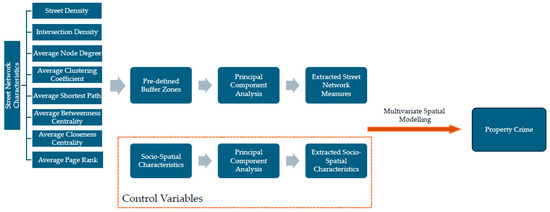
Figure 1.
Workflow of the research framework.
3.2. Case Study
Charlotte, North Carolina, is a well-suited site to study urban crime dynamics, as a microcosm of the fast-evolving reality of urban regions in the United States. As of mid-2023, Charlotte was the largest city in the state of North Carolina, with an estimated population of 911,311, reflecting a 4.2% increase since 2020 [55]. The city faces challenges in maintaining public safety as urbanization and immigration have maintained a steady pace of growth. It has a diverse demographic profile, with 43.1% White, 35.2% Black or African American, and 15.3% Hispanic residents. The population’s median age is impacted by a significant percentage of young people (22.9% under 18). Charlotte’s economy is robust, with a median household income of USD 74,070 and a civilian workforce participation rate of 71.9% [55]. Its blend of socioeconomic diversity, population growth, and urban sprawl contributes to its complex and multifaceted crime dynamics.
The street network of Charlotte is diverse, reflecting the city’s history of urban development. As highlighted by [56], Charlotte ranks among the most diverse U.S. metropolitan areas regarding the orientation and layout of streets. As illustrated in Figure 2, the urban core (Uptown) follows a traditional grid system that facilitates connectivity with high density of intersections. In contrast, suburban areas often feature curvilinear loop patterns or a conventional cul-de-sacs layout, which reduce the permeability of the urban fabric. This diversity in street network configurations offers a unique setting to study their potential impact on spatial crime dynamics.
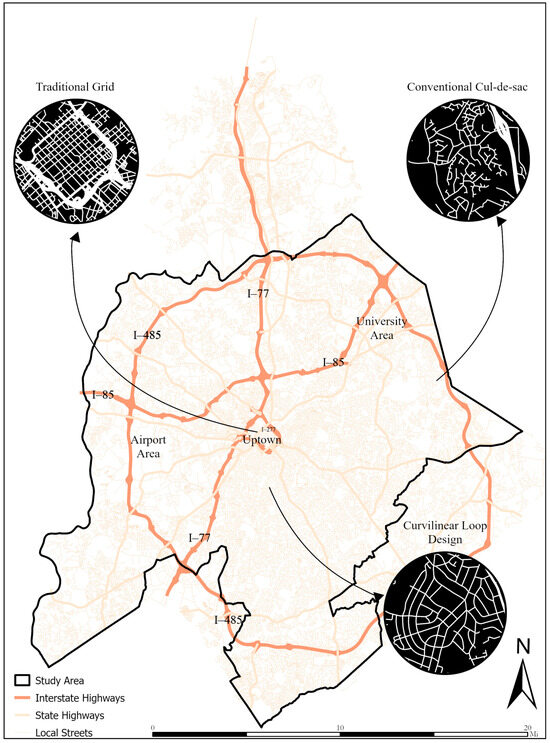
Figure 2.
Diversity of street networks in the study area.
Over the past five years, Charlotte has experienced sharp fluctuations in property crime. In 2023, property crime increased by 14%, largely stemming from a significant rise in auto thefts, which surged by 125% during that period. This highlights potential vulnerabilities in areas with a large population, high business activity, high vehicular activity, or limited oversight. This escalation may also point to broader systemic issues, such as economic challenges in certain neighborhoods, law enforcement limitations, and accelerating changes in urban growth dynamics. The significant increase in arrests (up by 12%) demonstrates heightened police responses, but also a growing need for proactive crime deterrence [57]. These trends offer an opportunity to investigate whether environmental factors, and specifically the characteristics of street network configuration, contribute to property crime across Charlotte’s neighborhoods.
3.3. Data
3.3.1. Overview
In the United States, property crimes encompass a variety of offenses including burglary, larceny-theft, motor vehicle theft, and arson [58]. In the City of Charlotte, property crimes are recorded by the Charlotte-Mecklenburg Police Department (CMPD), and tallies are reported publicly on the Charlotte/Mecklenburg Quality of Life (QoL) Explorer dashboard for 2022 by neighborhood [59]. The unit of analysis in this study is the Neighborhood Profile Area (NPA), a predefined geographical area used in the QoL dashboard. A series of socio-spatial variables are also reported on this dashboard at the granularity of NPAs, which facilitates data compilation and analysis. In addition, NPAs represent neighborhoods with shared socio-economic and demographic characteristics that distinguish them from other neighborhoods. This alignment supports the assessment of various quality-of-life factors in a neighborhood, including education, economic well-being, housing, and transportation. The City of Charlotte comprises 372 NPAs. The NPA encompassing Charlotte Douglas International Airport was excluded to avoid skewing results due to the unique street network characteristics and the distinct non-residential character of the airport area. Hence, 371 NPAs were used in this research.
3.3.2. Property Crime Data
In 2022, more than 30,000 property crimes were reported in the city of Charlotte. Given their recorded address, each event was assigned to a unique NPA. The primary dependent variable is the tally of property crimes that occurred in each NPA. The geography of property crimes is shown in Figure 3. For some modeling tasks, property crime is rescaled to the NPA, so the tally of property crimes per area (acres) constitutes an alternative dependent variable. This crime density is visualized in Figure 4.
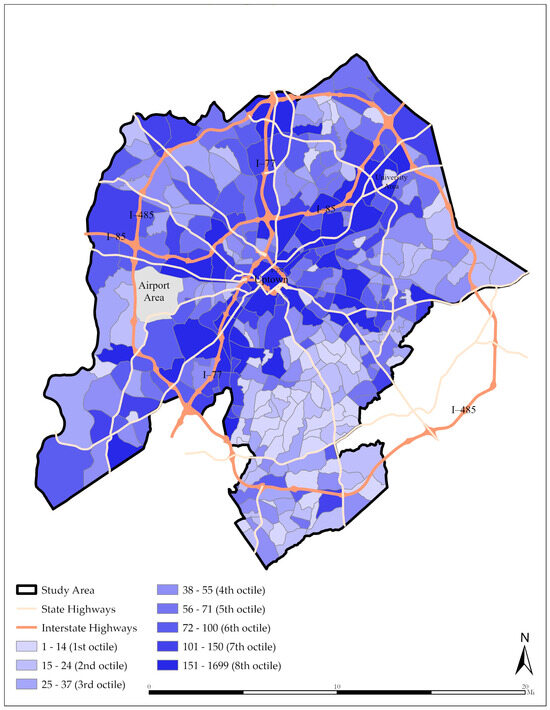
Figure 3.
Property crime counts across NPAs in 2022.
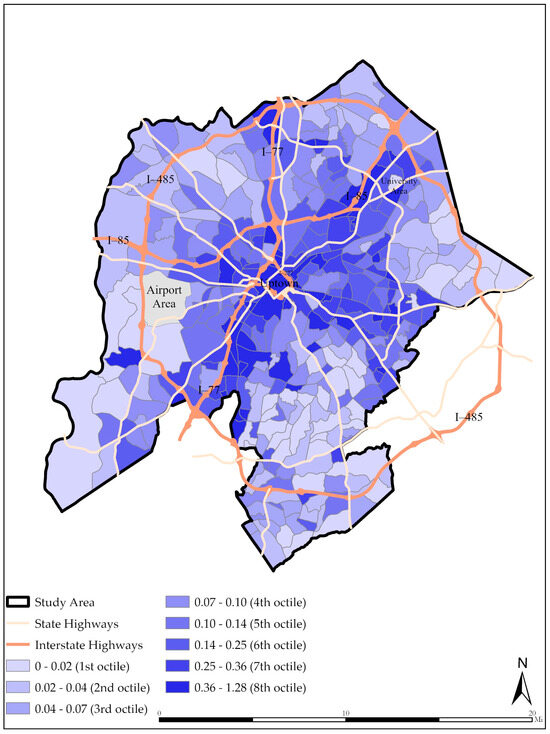
Figure 4.
Property crime density across NPAs (by acre) in 2022.
The distribution of property crime in Figure 3 indicates that the average occurrence of property crime is about 81 incidents per NPA, and standard deviation is approximately 124, suggesting strong overdispersion. The positive skewness of the distribution means that crime occurs with high frequency only in a few NPAs, following a Negative Binomial distribution with significant overdispersion.
To complete the overview of the geography of property crime in the study area and given the uneven spatial distribution of crime opportunities in this area, we also report on the density of crime events per acre. The average property crime density is relatively low at 0.175 per acre in 2022; however, the maximum rate of 1.280 per acre indicates that a small number of NPAs experience significantly higher crime levels. A standard deviation of 0.192 further reflects high overall variability, supporting the observation that crime is highly locally variable and unevenly distributed. The distribution of property crime rates deviates from a normal distribution and is positively skewed, with most NPAs clustered around lower crime rates. Specifically, 75% of NPAs have property crime rates below 0.253 per acre, underscoring that high-crime NPAs are a minority but represent critical areas for targeted interventions to address the factors underlying the elevated crime levels. The NPA encompassing the UNC Charlotte campus in the Northeastern part of the city has the lowest property crime rate, at 0.2 per acre. The highest property crime rate by area occurred in an NPA located in the southern part of Charlotte. Based on [60], this neighborhood consists mostly of multifamily (including affordable housing) residential buildings, with a large Hispanic population (82% of the population), and low educational attainment (7% of residents with a bachelor’s degree or higher).
3.3.3. Street Network Configuration
The configuration of the street network of each NPA can be apprehended through a series of metrics that each adopt a specific perspective. Here, eight key metrics covering the properties of the density, connectivity, accessibility, and centrality of elements of the street network were taken to comprehensively characterize the local street network. The selection of measures was informed by the need to capture a broad diversity of aspects of network structure in their local context, the availability of data for each NPA, and an extensive review of the practices in measuring the local properties of street networks [61,62,63,64,65,66,67,68]. The measures were defined and calculated as follows.
- Street Density (SD): This measures the total length of street segments within an NPA network divided by the areal size of the NPA. It captures the packing of the street infrastructure in the neighborhood. A higher density reflects a more accessible urban environment [69].
- Intersection Density (ID): As a second measure of network density, this represents the concentration of intersections in an NPA. It is calculated by dividing the number of nodes with a degree of three or more (indicating intersections) in the network by the NPA. Higher intersection density is associated with smaller block sizes, reflecting more interconnected streets [70].
- Average Node Degree (AND): This measure takes each street intersection (node) in each NPA and examines how strongly it is connected to other nodes. Specifically, it counts the number of street links (edges) incident at each node, defined as the node degree. The AND is the average of node degrees in each NPA. Higher AND values denote a more interconnected network, where nodes have more direct street connections [56].
- Average Clustering Coefficient (ACC): This reflects the indirect adjacent connectivity and the degree to which nodes in the network cluster together. Practically, the clustering coefficient of a node is defined as the ratio of the number of neighbor nodes connected to each other to the total number of possible connections between them [71]. The ACC averages these values over all nodes in an NPA. A higher ACC would describe a network with localized clusters, supporting short-range connectivity [72].
- Average Shortest Path (ASP): This is calculated by the average of paths with the shortest distance to travel between all pairs of nodes in the NPA network. A shorter ASP enhances local network accessibility [73].
- Average Betweenness Centrality (ABCe): The betweenness centrality quantifies how often a node acts as a bridge along the shortest path between any two other nodes [74]. Thus, a node with high betweenness value lies on many shortest paths between other nodes [75]. In this study, we measure the average betweenness value of nodes in an NPA network. Higher ABCe indicates a higher degree of interconnectedness of the local street network.
- Average Closeness Centrality (ACCe): This measure captures the extent to which nodes are close to all other nodes in a network, emphasizing the efficiency of interaction within the network [76]. Thus, a node with a high closeness value has a short path to all other nodes in the network, locating it at intersections that are central to the network’s structure [77]. The ACCe is the average of all nodes in the NPA network.
- Average Page Rank (APR): Page rank centrality focuses on the quantity, i.e., the degree of a node, and quality, i.e., the degree of nodes connected to that node of interest [78]. It concentrates on the direct and indirect role of a node in the network to determine its overall influence on its neighbors. Therefore, a node with a high page rank value has a high direct and indirect connectivity impact on the network. The APR averages the page rank centrality values of nodes in an NPA. A higher APR suggests more nodes play a central role in directly and indirectly connecting parts of the network.
The first two measures listed above are geometric, while the others are core features of graph theory. The eight measures of street network properties are summarized in Table 1.

Table 1.
Street network measures.
The street network data used in this study are derived from a street centerline dataset [86], which includes streets, major roads, and highways across the county. Several preprocessing steps are conducted to create a standardized, refined, and validated street network dataset. First, any extraneous or non-functional elements, such as roads labeled as “Retired”, as well as non-service roads, are removed to eliminate noise and non-representative pathways from the network. Second, nodes with only two degrees (indicating a continuation of a single road segment) are removed, and segments are merged to streamline the network structure and reduce redundancy. Finally, endpoint nodes are extracted to accurately represent intersections and dead ends within the street network. The Python 3.11 package NetworkX is employed to build the final network and calculate the street network measures.
The crime data sourced for this study reflect the occurrence of property crime within each NPA. However, as highlighted by theoretical frameworks such as Crime Pattern Theory and supported by empirical evidence, e.g., [87], the perceptual familiarity of offenders with a neighborhood is also shaped by movement patterns beyond its boundaries, underscoring the possible influence of the configuration of the street network beyond an NPA’s boundaries. Thus, a multi-scale design is presented, defining a bank of external buffer zones ranging from 0.1, 0.25, 0.5, 0.75, and 1 mile around each NPA to account for the full scope of local and non-local travel to crime in relation to NPAs, as illustrated in Figure 5. According to travel-to-crime research, property crimes tend to cluster in an offender’s awareness space, typically shaped by offenders’ habitual travel from their residence to regularly visited locations. Also, previous methodologies, such as [5,8,88,89], modeled spatial decay in crime risk using fixed buffer distances, distinguishing between local versus non-local traveling to crime. In the empirical studies, a range of distance buffers, especially for local mobility at 0.25 to 0.5 miles, and non-local travel at 0.75 to 1 miles, were selected to account for the travel-to-crime effect. Thus, the selected distance ranges in this study ensure the full representation of different forms of travel, while also attempting to address the unavoidable uncertainty and variation in defining optimal buffer distances, identified as an issue in previous accessibility and mobility studies.
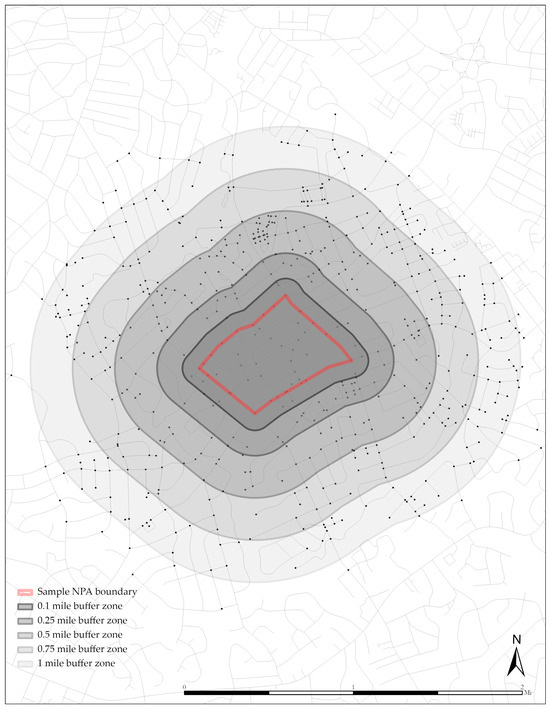
Figure 5.
Street network with pre-defined buffer zones for a sample NPA.
Additionally, multiple buffer zones help to reduce the effect of potential noise in the data, especially at boundary areas where cut-off points could distort or misrepresent the actual structure of the network. As a result, the buffer zones form concentric polygons, creating five nested street networks for each NPA. Then, eight network measures were calculated for each nested street network, resulting in 40 street network variables for each NPA.
Not unexpectedly, the 40 street network variables exhibit significant collinearity and cannot be used together as regressors. To address this issue, the dimensionality reduction technique of Principal Component Analysis (PCA) was employed. This technique is widely employed in fields such as computer science [90,91], finance [92,93], and social science [94,95] for pattern recognition, anomaly detection, and data compression. Here, a PCA with varimax rotation was performed on the street network variables to better understand the covariance structure among these metrics. The full workflow of the PCA of street network measures is presented in Appendix A.1. Given the shape of the scree plot of the PCA and given the patterns exhibited by the component commonalities and loadings, a four-component solution was retained, which accounts for 74.1% of the collective variance of the 40 variables. Guided by the matrix of component loadings, we selected one variable to represent each of the four components to reduce information redundancy while maintaining the ease of interpretation (Table 2). This approach controls collinearity and preserves the unique properties of the study area’s diverse street network. Additionally, all network measures were log-transformed to uphold their homoscedasticity after a unit value is added to ensure non-negative outputs.

Table 2.
Extracted street network measures.
The four retained street network variables are mapped in Figure 6. They exhibit distinctive spatial patterns that are hypothesized to be significant factors of property crime at the NPA level. Descriptive statistics of the selected street network variables are reported in Table 3.
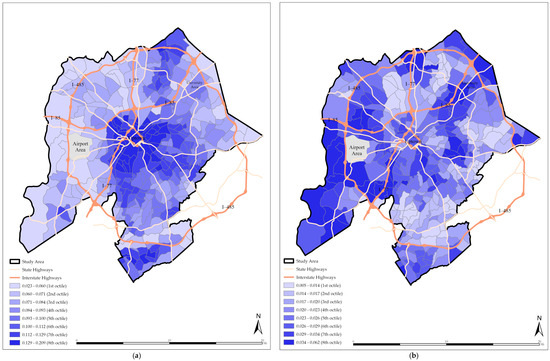
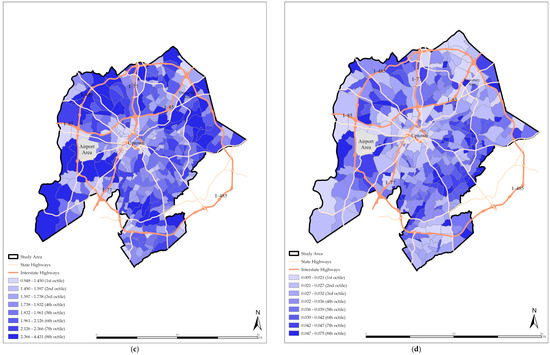
Figure 6.
Spatial distribution of selected street network variables: (a) intersection density with 0.75-mile buffer zone; (b) average clustering coefficient with 0.75-mile buffer zone; (c) average shortest path with 0.75-mile buffer zone; (d) average betweenness centrality with 0.5-mile buffer zone.

Table 3.
Descriptive statistics of the selected street network variables.
3.3.4. Controlling for Socio-Spatial Characteristics
As reported in the literature review, a variety of socio-spatial characteristics of neighborhoods are known to be associated with criminal activity. To control the effect of the socio-spatial characteristics of an NPA on property crime, we selected an original set of 16 control variables as possible factors in the multivariate models, which align with the extant literature. These measures were drawn from several sources, including American Community Survey (ACS) and Mecklenburg County Tax Parcel data, and were reported on the Mecklenburg County QOL dashboard. They provide essential context, helping to isolate the effects of street network configuration on property crime by controlling factors such as income levels, education levels, racial and ethnic characteristics, housing characteristics, etc. The complete list of control variables, their definition, and their source are reported in Table 4.

Table 4.
Socio-spatial variables used as control variables in the multivariate models.
The 16 socio-spatial control factors exhibit strong collinearity. To alleviate the detrimental effects of collinearity on regression estimates while preserving their controlling power, a PCA with varimax rotation was applied. A nine-component solution was selected based on the shape of the scree plot and the distribution of commonalities and component loadings. The full workflow of the PCA of socio-spatial characteristics is presented in Appendix A.2. The interpretation of the nine components is provided in Table 5.

Table 5.
Extracted components of socio-spatial characteristics.
3.4. Multivariate Methods
Four different multivariate models regress the count of property crime on the four street network measures, while controlling for the effects of socio-spatial factors. While each of these modeling approaches features specific properties, we aimed to compare them and identify consistencies in the estimation results to draw robust conclusions regarding the role of street network configuration in property crime. They explicitly recognize that property crimes are discrete events and use the count of crimes as a dependent variable. As stated earlier, this count variable follows a Negative Binomial (NB) distribution; hence, the following models were adjusted based on that characteristic. The four NB models use a log-transformed exposure offset that was scaled according to the area size of each NPA, so differences in exposure among NPAs were incorporated and the property crime counts were appropriately scaled. This not only addresses some of the disadvantages of using property crime density as the dependent variable, which can inflate perceptions of risk in small or low-population areas, but allows us to assess the absolute number of crimes while controlling for neighborhood size variations. Employing counts with an exposure offset ensures statistical validity as well as a meaningful interpretation of the built environment. Additionally, area size was deemed to be an appropriate offset variable because property crime has a diverse nature, where some crimes affect residential buildings, others target commercial buildings and properties, and many crimes have vehicles in residential neighborhoods and activity centers as the target. To test for overdispersion, we followed the approach in [99]. The overdispersion ratio was measured in the R environment using the Check Overdispersion function. Test results indicate that overdispersion is effectively handled by models that assume an NB distribution.
First, serving as a benchmark, an NB-based GLM was used to test the influence of street network measures employing a methodology by [100] implemented in R using the GLM.NB function. The second and third NB-based models incorporate the spatial lag effect, i.e., SAR, and spatial random effect, i.e., CAR, into the base GLM within a Bayesian environment, employing the Integrated Nested Laplace Approximation (INLA) approach developed in [101] for estimation purposes, which was implemented in R using the INLA function. The primary motivation for employing a Bayesian approach lies in its flexibility and robustness in integrating complex spatial models, such as Spatial Autoregressive (SAR) and Conditional Autoregressive (CAR) structures, with a Negative Binomial distribution to account for overdispersed count data. Unlike frequentist approaches, which often face computational or methodological limitations when estimating such models, Bayesian methods allow for direct and efficient estimation while also providing full posterior distributions for inference. Finally, to account for local variations in the base GLM, a Geographically Weighted Regression NB-based (GWR-NB) model was tested using the approach developed in [102] and implemented by the GGWR function in R. In all the models, customary diagnostic tests for homoscedasticity and collinearity were conducted. Also, the W spatial weight matrix was specified in the spatial models based on the queen’s adjacency.
Each modeling technique applied in these multivariate methods was chosen to address specific characteristics of spatial crime data. The Negative Binomial GLM serves as a benchmark model, accounting for overdispersion in the count data without spatial adjustments. The SAR-NB model captures spatial lag dependence, allowing us to assess whether property crime in one neighborhood is influenced by property crime in surrounding areas. The CAR-NB model accounts for unobserved spatial heterogeneity by modeling random effects based on the spatial proximity of the neighborhoods. Lastly, the GWR-NB model allows for local variation in parameter estimates, revealing whether the relationship between street network configuration and property crime is stationary or varies across space. Each model thus provides a complementary perspective that enriches our understanding of how street network features influence property crime.
4. Results
We start with an exploratory spatial analysis of property crime events across the study area. The spatial analysis of the count of property crime in Charlotte indicates that property crime is positively autocorrelated. The estimated Global Moran’s I on the property crime count is 0.120 (using the inverse distance method) and statistically significant at 95%. Citywide, property crime tends to follow clustered patterns across neighborhoods. A local analysis of clustering using the local Moran’s I informs about the specific placement of various types of clusters, as illustrated in Figure 7a. A high occurrence of property crime is clustered in the city’s urban core, with significant arterials to the Southwest and, to a lesser extent, to the Northeast. Also, low-crime clusters predominantly form patches located in the affluent suburban outskirts. Sparse transition areas (High–Low or Low–High clusters) occur around hot and cold spots. Property crime rates show stronger spatial dependence globally (Moran’s I of 0.30, significant at 0.05). As illustrated in Figure 7b, the local Moran’s I on crime rates points to the same clustering trends as for crime counts, but the patches of significant clusters are more prominent. Thus, the geography of property crime exhibits some clear and explicit spatial trends. These trends call for a detailed and rigorous analysis that sorts out the ecological factors, focusing on factors of the built environment, such as the street network layout, while controlling for other socio-spatial factors of urban communities.
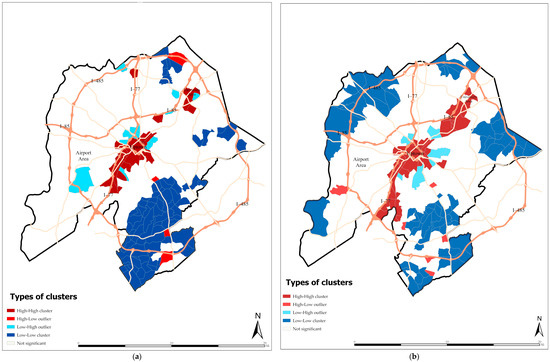
Figure 7.
LISA clustering map of: (a) property crime count across NPAs; (b) property crime density across NPAs.
Before performing multivariate modeling, it is essential to assess multicollinearity among the explanatory variables. As mentioned in the previous section, separate PCA procedures applied to the street network measures and to socio-spatial variables ensure that the selected components within each category are not internally collinear. However, collinearity could still exist between the components derived from the two PCAs. To evaluate this possibility of multicollinearity, a Variance Inflation Factor (VIF) analysis was conducted across all selected variables. As shown in Table 6, the results indicate no significant multicollinearity between the street network and socio-spatial variables.

Table 6.
Variance inflation factor (VIF) results for street network and socio-spatial components.
In this study, the modeling of the relationship between street network measures and property crime counts began with a Generalized Linear Model (GLM) using a negative binomial distribution. The estimation results of the NB-based GLM are reported in Table 7. The model has strong explanatory power, as 47% of the variation in property crime is explained by the model. We find that the ID and ACC measures have a significant positive association with property crime. This suggests that neighborhoods with denser and more interconnected street layouts tend to experience higher levels of property crime. The ASP presents a significant negative association, implying that neighborhoods with greater average distance between nodes tend to experience fewer property crimes. The ABC measure is not statistically significant.

Table 7.
Summary statistics of the NB-based GLM.
Among the latent socio-spatial factors used as control variables, six components are statistically significant at the 0.01 level and one is significant at the 0.05 level. However, components 6 and 9, corresponding to employment rate and the median age of residents, respectively, are not significant, indicating they are contextually not relevant to the occurrence of property crime in Charlotte. The significant autocorrelation in residuals implies that parameter estimates are likely to be biased and inefficient. Hence, there is strong evidence that the multivariate model ought to account for spatial effects.
After identifying the presence of spatial components in the base model, these components were explicitly included in two separate models. The first spatial model includes the spatial lag effect through a spatial autoregressive modeling (SAR) framework for an NB distribution of the dependent variable. To achieve higher accuracy in the results, the model was developed within a Bayesian framework. Specifically, in this model, the priors for the hyperparameters were chosen to reflect reasonable assumptions about the underlying processes. To ensure the precision of the random effects, a log-gamma prior was used with shape and rate parameters set to 0.10 each. The shape and rate parameters of the log-gamma distribution help control the distribution’s form; the shape parameter influences the “steepness” of the prior, while the rate parameter controls how spread out the values are. The value of 0.10 for both reflects that we are not very certain about the precision but still believe it should be positive. For the spatial correlation parameter (Rho), a logit-beta prior was applied with parameter set to 1, which corresponds to a uniform prior between 0 and 1. This choice indicates that we do not have strong prior knowledge about the level of spatial correlation, so it can range freely within this interval. The fixed effects do not have explicitly defined priors; therefore, default non-informative priors were used, meaning that we did not make any strong assumptions about their values a priori.
As the results show in Table 8 and Figure 8, the posterior distribution for the ID measure points to a positive effect on property crime in all instances; standard deviation is low (relative to the mean) compared to that of other street network measures. Next, the ASP’s posterior effect distribution indicates an 86% probability that the effect on property crime is negative, with high standard deviation in relation to the mean. The distribution of posterior effects imputable to the ABC measure is scattered across a range of positive and negative values, with about 81% probability that it has a negative effect on the number of property crimes. Thus, this indicates a marginally meaningful negative effect on the occurrence of property crime within the 81% credible interval. Also, its standard deviation is high (relative to the mean) compared to the other street network measures. Finally, the posterior effect of ACC fluctuates broadly between positive and negative values, which is evidence against a definitive direction of its effect on property crime within a 69% credible interval. The distribution of its posterior effect also highly deviates compared to other street network measures.

Table 8.
Summary statistics of the spatial autoregressive negative binomial (SAR-NB) model.

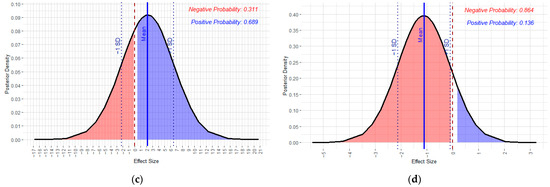
Figure 8.
Posterior distribution of street network parameters in the SAR-NB model: (a) average betweenness centrality; (b) intersection density; (c) average clustering coefficient; (d) average shortest path.
The distribution of the spatial autocorrelation component (Rho)’s posterior effects suggest that the spatial lag component, indicative of spatial dependence, has a highly consistent likelihood of having a positive impact on the number of property crimes (very low standard deviation compared to the mean). The model fit statistics, which are Bayesian estimates that can directly be compared to the GLM base model, suggest that the SAR model provides a better fit than the base model.
The second alternative multivariate model incorporates spatial random effects. It is a conditional autoregressive (CAR) model for an NB distribution of the dependent variable; like the SAR model, it is estimated in line with Bayesian principles. Similarly, a log-gamma prior to the precision of the random effect and default non-informative to the fixed effects are assigned. The estimation results in Table 9 and Figure 9 indicate that the model fit is slightly improved compared to the base model, but it is a lower fit than the SAR-NB model. As for the parameter estimates for the network measures, we find that the distribution of the ID’s posterior effect points to a positive effect on property crime in all instances; standard deviation is low compared to that of other street network measures. Next, the ASP’s posterior effect distribution indicates a negative effect on property crime in 99% of all instances, with low standard deviation compared to that of other street network measures. As for the ABC parameter estimates, about 97% of the posterior distribution is negative, with a moderately high standard deviation compared to the other street network measures. Finally, the ACC’s posterior distribution shows a marginally meaningful positive effect within the 83% credible interval. However, this is accompanied by a very high standard deviation. Lastly, the spatial random effect component points to a positive effect on property crime in all instances; standard deviation is low given the mean effect, which indicates consistency in the estimated effect.

Table 9.
Summary statistics of the conditional autoregressive negative binomial (CAR-NB) model.
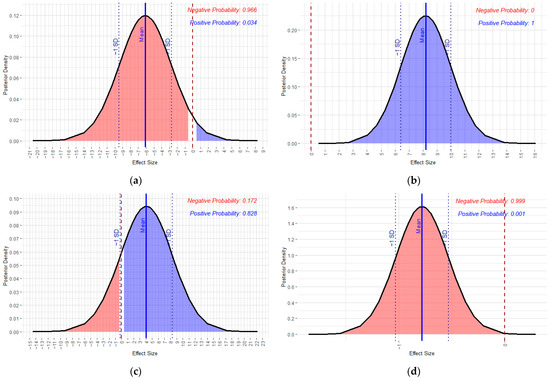
Figure 9.
Posterior distribution of street network parameters in the CAR-NB model: (a) average betweenness centrality; (b) intersection density; (c) average clustering coefficient; (d) average shortest path.
Lastly, under the assumption of non-stationarity of the relationship between street network measures and property crime, the GWR-NB model provides estimates at the local scale. The model defines an optimal mid-range bandwidth of 6.39 miles for spatial heterogeneity analysis. Interestingly, while the model determines the optimal size of the spatial kernel endogenously, the optimal granularity is not hyper-local. As reported in Table 10, the diagnostic tests indicate no improvement in the fitness of the model compared to the base, SAR-NB, and CAR-NB models.

Table 10.
Summary statistics of the geographically weighted regression negative binomial (GWR-NB) model.
Let us look specifically at the estimated effects of the four street network variables (Table 10 and Figure 10). The effect of ID on property crime is positive and statistically significant in all instances of local areas, with fairly moderate changes across local areas. Also, based on the median standardized coefficients, we find that ID’s influence on crime is stronger than other network measures and only one socio-spatial factor exceeds this influence. The effect of ACC on the count of property crime is significant in most instances of local areas; however, this effect exhibits tremendous fluctuations spanning from positive to negative. Also, the median effect indicated by the standardized coefficient of ACC (Table 10) is weak compared to other tested regressors. The ABC is also significant across most local areas, but its effect fluctuates widely between positive and negative effects. The median of this effect is weak compared to other street network measures and even compared with socio-spatial factors. Finally, ASP’s effect is consistently negative over all local kernel estimations, with a low deviation compared to other street network measures, but significant only in small portions of the local areas. Its median influence on crime is small overall, as indicated by the median standardized coefficient.
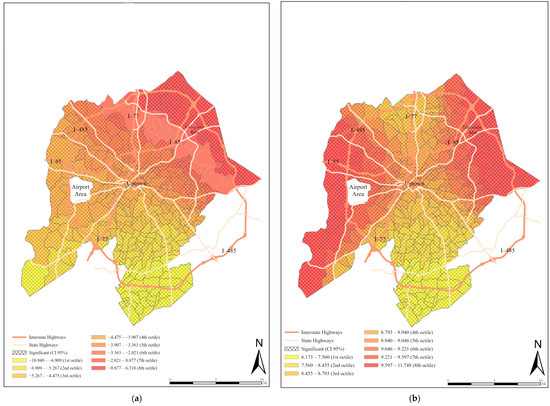
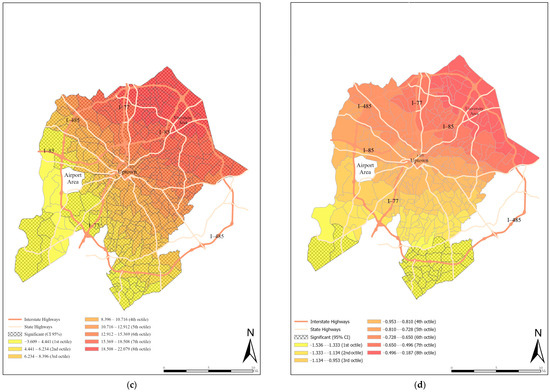
Figure 10.
Local coefficient significance of the geographical weighted regression negative binomial (GWR-NB) model: (a) average betweenness centrality; (b) intersection density; (c) average clustering coefficient; (d) average shortest path.
5. Discussion
The relationship between the built environment and crime is multifaceted, potentially influenced by various factors and contexts, and street network configurations constitute a significant built environment element that shapes crime pattern. This study contributes to advancing the knowledge of this relationship by considering a range of spatially explicit measures of urban street network configurations and testing their influence on property crime with several multivariate models incorporating spatial dependence and spatial heterogeneity effects. In this case study, property crime is analyzed at the scale of small urban neighborhoods as a count variable. While controlling for the effect of a range of socio-spatial factors, we found that property crime is consistently affected by the local properties of the street network, with statistical significance and credibility. The strong consensus that emerged from our analysis stands in contrast with the lack of consensus in the literature on the direction and magnitude of the impact of specific street network characteristics on crime. The properties of city street networks that were very consistently found to be influential include the Intersection Density and Average Shortest Path measures, which are positively and negatively associated with property crime, respectively.
Regarding the connectivity of the street network, much of the literature places more weight on a positive association between Intersection Density and property crime. In our analysis, the SAR-NB and CAR-NB models, which incorporate spatial dependence and random effects, further validate the relationships identified in the baseline model. Intersection Density remains a robust predictor across all models, consistently showing a positive effect on property crime. The findings from the multivariate models developed in this study strongly and consistently support this positive relationship in the base and spatially enabled modeling of our study area. The consistent positive effect of intersection density aligns with Routine Activity Theory, which suggests that high connectivity leads to more pathways and increases encounters with vulnerable targets. These findings support previous work by [5,8,11,32,34,35,36,37,38,39,40,41], which similarly identify network connectivity as a key environmental factor influencing crime patterns.
Indirect connectivity in a neighborhood’s network, captured by the Average Clustering Coefficient measure, positively influences property crime in our base model. However, its effect is weakened and less stable when spatial components are incorporated into the base model, with a high degree of variation in its effect, leading to a less robust impact on the occurrence of property crime. The inconsistent impact of the Average Clustering Coefficient implies that indirect connectivity’s relationship to crime is highly localized and contextual, and possibly less likely to be generalizable to other urban settings.
In the case of accessibility, the Average Shortest Path measure in a neighborhood’s street network is also negatively associated with property crime in the base and spatially enabled models. Average Shortest Path retains its overall negative relationship, reinforcing the idea that accessibility is a double-edged sword in urban design; it promotes mobility but may also enhance the reach of offenders. The SAR model suggests, however, that ASP’s effect lacks statistical consistency. Overall, our results are consistent with the literature, such as [32,38], regarding the extent to which shorter routes lead to increasing offender mobility, aligning with Situational Crime Prevention (SCP) strategies, which emphasize environmental designs that increase offender effort. Longer travel paths between network nodes may increase the perceived risk or time commitment required to offend.
Finally, no significant relationship is observed between the centrality aspect of a neighborhood’s network, captured by the Average Betweenness Centrality measure, and property crime in the base model. The inclusion of spatial components in CAR and GWR models lead to mixed results with an unclear association with property crime. Only with the CAR model is there some evidence of a negative effect of centrality on crime. Hence, this result stands in contrast to [36,103], where a positive relationship between street network centrality and burglary rate was found. A potential explanation for this divergence lies in Charlotte’s unique urban morphology. Unlike traditional grid-based city centers, where high betweenness often coincides with high foot traffic and passive surveillance, many high-BC areas in Charlotte may represent arterial roads or commercial corridors that are heavily trafficked by vehicles but lack pedestrian presence and social guardianship. These areas might attract property crime due to low visibility, poor walkability, and fragmented land uses. Furthermore, Charlotte’s low-density zoning, cul-de-sac-driven street design, and urban sprawl may result in high BC values that do not translate to increased informal social control.
To help synthesize findings across models, Table 11 presents a summary of the key street network variables, their expected directional relationship based on theory and literature, and their observed effects across our four models. This format highlights the robustness of intersection density and average shortest path as consistent predictors of property crime, while also illustrating the spatial variability and context sensitivity of measures like average betweenness centrality and average clustering coefficient.

Table 11.
Summary of analytical results regarding street network variables and the direction of influence on property crime, positive (+) or negative (−).
The local scale of the street network relationship with property crime reveals some context-dependent spatial patterns. Suburban areas exhibit a stronger positive influence of intersection density and a weaker negative influence of the average shortest path on property crime than the city center, characterized by a high-density central business district (CBD). This may stem from the predominance of residential land use in the suburbs, suggesting that increasing connectivity and accessibility in residential neighborhoods may intensify opportunities for property crime more than in Charlotte’s urban cores. This finding aligns with prior research, e.g., [104], which emphasizes the importance of accounting for the interplay between land use, street networks, and crime activity. Another reason for the different intensity of the local effects may be due to the mixed effect of connectivity and accessibility on property crime through encouraging vehicular traffic flow from outside, and in parallel, increasing pedestrian activity, leading to a higher level of natural surveillance. The absence of consistent foot traffic in suburban cul-de-sac neighborhoods can render them more vulnerable to property crime, particularly if increased permeability facilitates outsider access. In contrast, downtown grid-like areas benefit from continuous pedestrian activity, which contributes to natural surveillance and crime deterrence. This aligns with the findings of [105], who argue that the criminogenic impact of permeability is more pronounced in low-density suburban areas with limited informal surveillance. However, this intense effect is not uniform across all suburban neighborhoods. For instance, the affluent southern suburbs of the city show an even weaker influence of connectivity on property crime than the CBD. This is particularly a significant point because the major socio-spatial characteristics of the neighborhoods have already been controlled for in the model. This raises the possibility that other unmeasured factors, such as long-standing perceptions of safety and stronger informal guardianship in affluent southern neighborhoods, may mediate or suppress the criminogenic effects of connectivity in those areas. This observation aligns with the existing literature, e.g., [106], that emphasizes the significance of how neighborhoods are perceived in shaping criminological outcomes. Overall, the observed local variation underscores the importance of accounting for latent factors such as land use, traffic type and volume, and residents’ perceptions of spatial safety patterns within the urban environment.
Spatially explicit modeling was found to enhance the robustness of the statistical analysis. It was found that spatial components in the form of spatial lag or spillover, spatial random effect, or spatial heterogeneity all enhance the explanatory power of the multivariate modeling of property crime, while avoiding spurious and biased relationships. Notwithstanding these enhancements, the relationship between street network configuration and crime was found to remain rather consistent. While crime exhibits a strong local pattern of variability at a fine granularity, the role of street network configuration is manifested most effectively at a coarser resolution that spans across broader sections of the urban area. Our spatially explicit approach strengthens the empirical foundation for urban design strategies that aim to reduce crime. It emphasizes that urban planners and policymakers must consider both the intended and unintended consequences of street network designs.
The rigorous street network construction process performed in this study enhances the robustness of the model results. Certain studies, such as [8,36,38], have utilized predefined fixed buffer zones to distinguish between local and non-local activities, alongside potential distortions when measuring the street network measures at the borders of the study area. Also, the inconsistency in fixed parameters, which originated in accessibility studies, creates variability in defining an optimal solution. A critical novelty of this study of urban analytics is in its ability to define a series of buffering bands around each neighborhood, and in its employing a PCA dimensionality-reduction approach to extract key themes of street network characteristics within and beyond the neighborhood. This approach captured a more comprehensive and encompassing range of possible travel patterns within and beyond the neighborhoods. This also circumvents the potential inconsistency observed at the edges.
While the results of this study offer valuable insight into the relationship between street network configuration and property crime, several limitations should be highlighted. Correlational studies in environmental criminology can reveal associations [25], but identifying causal mechanisms includes significant challenges [107], as the manipulation of real-world street networks to enable true experimental causal inferences is impractical. Even if a relationship can be established, it may be intricate [8]. Additionally, as noted by [108,109], the causal mechanisms of structural characteristics may vary across spatial scales, as highlighted in the varying results at the global and local scales of this study, which, in this respect, supports other studies of spatial crime analytics [25,110]. Accordingly, several enhanced features should be included in explanatory spatial models for examining the connection between the configuration of the street network and property crime. The use of NPAs in this study obscures micro-scale property crime dynamics, e.g., hotspots at street segments, assessed in several built-environment criminology studies, such as [4,8,25,39]. However, the major challenge is the lack of granular property crime data at such a micro-scale level in our case study. Thus, a spatially pinpointed occurrence of property crime would enhance the robustness of both local and global spatial models.
Second, the temporal aspect should be incorporated into spatial models to overcome its static and cross-sectional nature, providing assistance to the establishment of causal inference. Given the novelty of this research on a multi-scalar spatial modeling of the relationship between street network configuration and property crime, significant advances are required to incorporate the temporal dynamics of street network configuration, property crime, and socio-spatial controlling variables. This could serve to integrate the methodology of this study into the body of built-environment criminology research that employs temporal dimensions alongside the spatial modeling in its methodological framework, such as [11,111,112,113]. In addition, advanced spatio-temporal modeling techniques that combine machine learning and spatial econometrics may be helpful, capturing the dynamic relationships between property crime and street network measurements over time, as well as providing a fuller contextualization of these relationships via socio-spatial ecological mediators.
Third, the scope of the relationship between street network characteristics and property crime was limited to vehicular networks. Nonetheless, many property crimes are influenced by offenders’ spatial decision-making processes, shaped by pedestrian networks. This limitation is largely due to the lack of a robust pedestrian network dataset for our case study area. In spite of the increasing enrichment of open access and open data platforms such as OpenStreetMap (OSM) with such data, the data quality and consistency require further investment. Finally, the micro-scale urban design, particularly the type of major roads highlighted in early place-based criminology studies and the macro-level framing, such as [45], represent another important dimension that could affect the robustness of the study’s models. Although our street network metrics capture structural characteristics, including connectivity, accessibility, and clustering, they do not directly quantify the role of arterials or high-traffic roads within neighborhoods.
6. Conclusions
This study aimed to investigate the effect of street network configuration on the distribution of property crime while incorporating spatial effects and controlling for known socio-spatial covariates. The empirical results conclude that certain characteristics of street networks, including connectivity and accessibility, strongly affect the occurrence of property crime in neighborhoods in line with existing criminology theories, and that including spatial effects can significantly improve the robustness of this relationship. The findings reveal that property crime exhibits spatial autocorrelations, indicating that the occurrence of property crime is not spatially random, but is more likely in adjacent neighborhoods. Also, heterogeneity in the relationships between regressors and crime is present, spanning mid-range distances over the study space.
While this study draws on existing tools in spatial econometrics and urban network analysis, its contribution lies in the novel integration of these methods to address multiscale dynamics in property crime. Specifically, our use of external buffer zones and the utilization of a PCA-based dimensionality reduction technique allow for the modeling of both local and non-local travel to crime and for the systematic identification of patterns in the street network configuration. Moreover, we incorporate a comprehensive list of street network measures, which, to our knowledge, have not previously been examined holistically in relation to property crime in a street network context. The inclusion of both global and local spatial models further enables a nuanced understanding of geographic variation in crime–street network relationships, particularly in suburban vs. urban cores. Together, the evidence-based results of this study enrich the empirical and methodological discourse on how built environment configurations shape property crime risk.
The findings of this study have important implications for both environmental criminology research and practical urban planning. Theoretically, the consistent effects of intersection density and average shortest path support and extend existing frameworks, such as Crime Pattern Theory and Routine Activity Theory, by emphasizing how specific network configurations influence property crime risk. Notably, the nuanced and occasionally contradictory effects of centrality highlight the need for the further refinement of environmental criminology models to account for spatial heterogeneity and local context. Practically, the results suggest that urban planners and policymakers should critically assess how street network design contributes to crime opportunity structures. Additionally, law enforcement agencies may use street network metrics to identify high-risk areas for targeted patrols or crime prevention initiatives.
This analysis can be extended in several meaningful directions. First, analyzing the street network structure and buffer zones would ideally occur at a micro-level, such as around each specific property crime location or, as suggested in several studies, at the level of individual street segments. Additionally, this paper focused on vehicular street networks, and some inconsistencies between the results of this study and the literature may stem from not considering the pattern of crime across two distinct vehicular and pedestrian networks. Therefore, incorporating data on modes of travel, such as pedestrian and transit-based mobility, along with measures of pedestrian networks, such as sidewalk connectivity and walkability, could further strengthen the analysis. Also, we defined street network measures that capture various aspects of the street network configuration. However, selecting additional measures may further enhance the model and the identification of the multiscalar effects of the built environment on crime. For instance, micro-level road design complexity, encompassing detailed features such as traffic-calming measures, sidewalk availability, and street lighting, can influence pedestrian and vehicular flow, influencing the occurrences of property crime. Lastly, future spatial models should account for the compounding or mitigating effects between features of the built environment and socio-spatial factors.
Author Contributions
Conceptualization, Erfan Kefayat and Jean-Claude Thill; methodology, Erfan Kefayat and Jean-Claude Thill; software, Erfan Kefayat; validation, Erfan Kefayat and Jean-Claude Thill; formal analysis, Erfan Kefayat and Jean-Claude Thill; investigation, Erfan Kefayat and Jean-Claude Thill; resources, Jean-Claude Thill; data curation, Erfan Kefayat; writing—original draft preparation, Erfan Kefayat; writing—review and editing, Erfan Kefayat and Jean-Claude Thill; visualization, Erfan Kefayat; supervision, Jean-Claude Thill; project administration, Jean-Claude Thill; funding acquisition, Jean-Claude Thill. All authors have read and agreed to the published version of the manuscript.
Funding
This research received no external funding.
Data Availability Statement
The raw data supporting the conclusions of this article will be made available by the authors on request.
Conflicts of Interest
The authors declare no conflicts of interest.
Appendix A
Appendix A.1
This appendix presents the results of the PCA conducted on the street network configuration measures. Figure A1 displays the scree plot used to determine the optimal number of components. As shown in the figure below, the curve exhibits an elbow in the range of four to six components. Solutions in that range were considered and varimax rotated. The search for strong communalities (Table A1) and ready scientific interpretability of component loadings with respect to the components (Figure A2) led us to retain a rotated solution with four principal components that effectively summarize the original 40 street network variables.
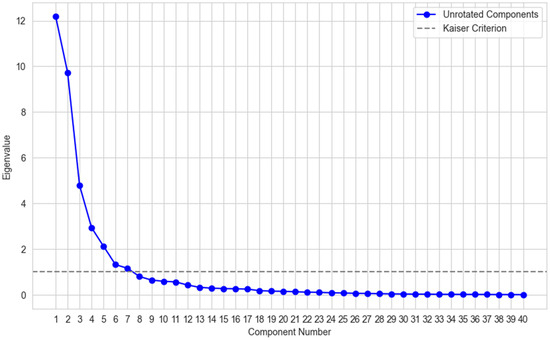
Figure A1.
Scree plot for street network measures.
Figure A2 reports the loadings or the strength and direction of the correlations between the original variables and each component. Each loading is a simple correlation that indicates the intensity of a variable loading onto each component. As the figure represents, component 1 is heavily influenced by intersection density, node degree, and street density at various scales, suggesting this component could be related to network intensity and connectivity. Component 2 shows high loadings for clustering coefficient and centrality measures, indicating a component linked to local clustering and centrality structure. Component 3 captures the variation in the shortest path at various buffer scales, which reflects access in the network. Finally, component 4 is shaped by clustering coefficients at larger scales, representing aspects of indirect network connectivity.
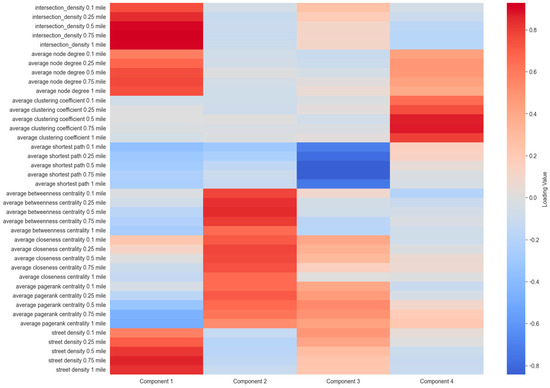
Figure A2.
Heatmap of rotated component loadings of street network measures.
To validate whether the four retained components explain the variance in the original variables, the communality of each variable was analyzed. The communality is the proportion of each variable’s variance that is collectively explained by the four retained components. A higher communality indicates that the four retained components account for most of the variance in that variable. Table A1 summarizes the communality for each street network measure. As the table represents, many variables have a communality above 0.70, indicating that the retained factors represent these variables well. The retained components are effective at capturing over two thirds of the variables of the street network configuration measures (Table A2).

Table A1.
Communality of the street network measures for the retained components.
Table A1.
Communality of the street network measures for the retained components.
| Variable | Communality |
|---|---|
| Intersection Density 0.1 Mile | 0.635 |
| Intersection Density 0.25 Mile | 0.762 |
| Intersection Density 0.5 Mile | 0.861 |
| Intersection Density 0.75 Mile | 0.92 |
| Intersection Density 1 Mile | 0.88 |
| Average Node Degree 0.1 Mile | 0.542 |
| Average Node Degree 0.25 Mile | 0.695 |
| Average Node Degree 0.5 Mile | 0.788 |
| Average Node Degree 0.75 Mile | 0.788 |
| Average Node Degree 1 Mile | 0.717 |
| Average Clustering Coefficient 0.1 Mile | 0.428 |
| Average Clustering Coefficient 0.25 Mile | 0.585 |
| Average Clustering Coefficient 0.5 Mile | 0.754 |
| Average Clustering Coefficient 0.75 Mile | 0.762 |
| Average Clustering Coefficient 1 Mile | 0.627 |
| Average Shortest Path 0.1 Mile | 0.743 |
| Average Shortest Path 0.25 Mile | 0.779 |
| Average Shortest Path 0.5 Mile | 0.816 |
| Average Shortest Path 0.75 Mile | 0.776 |
| Average Shortest Path 1 Mile | 0.625 |
| Average Betweenness Centrality 0.1 Mile | 0.659 |
| Average Betweenness Centrality 0.25 Mile | 0.716 |
| Average Betweenness Centrality 0.5 Mile | 0.766 |
| Average Betweenness Centrality 0.75 Mile | 0.729 |
| Average Betweenness Centrality 1 Mile | 0.541 |
| Average Closeness Centrality 0.1 Mile | 0.715 |
| Average Closeness Centrality 0.25 Mile | 0.741 |
| Average Closeness Centrality 0.5 Mile | 0.683 |
| Average Closeness Centrality 0.75 Mile | 0.576 |
| Average Closeness Centrality 1 Mile | 0.447 |
| Average PageRank Centrality 0.1 Mile | 0.607 |
| Average PageRank Centrality 0.25 Mile | 0.744 |
| Average PageRank Centrality 0.5 Mile | 0.845 |
| Average PageRank Centrality 0.75 Mile | 0.871 |
| Average PageRank Centrality 1 Mile | 0.738 |
| Street Density 0.1 Mile | 0.57 |
| Street Density 0.25 Mile | 0.693 |
| Street Density 0.5 Mile | 0.782 |
| Street Density 0.75 Mile | 0.829 |
| Street Density 1 Mile | 0.769 |

Table A2.
The share of total variance explained by each rotated component based on street network measures.
Table A2.
The share of total variance explained by each rotated component based on street network measures.
| Component | Share of Variance |
|---|---|
| Component 1 | 0.26 |
| Component 2 | 0.20 |
| Component 3 | 0.13 |
| Component 4 | 0.11 |
| Total | 0.70 |
Appendix A.2
Similarly, the results of the PCA on socio-spatial measures are reported below. Figure A3 shows the scree plot over the full range of possible components. While the curve has an elbow in the range of three to five components, an interpretable clustering of variables as evidenced by loadings was secured only for nine components. Also, as the figure shows, the components contribute negligible explanatory power beyond nine. Thus, nine components were retained, which accounted well for the original 16 socio-spatial measures.
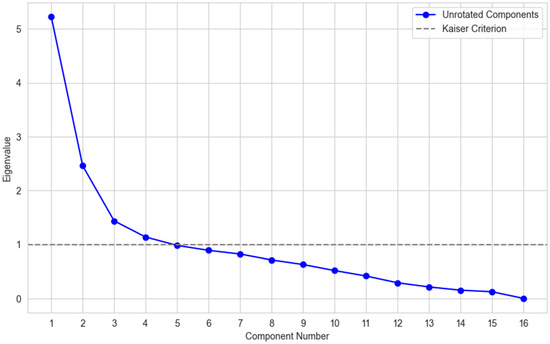
Figure A3.
Scree plot for socio-spatial variables.
In Figure A4, the components are discriminatingly associated with variables based on high correlation values. Together, the nine extracted components represent the original 16 socio-spatial variables and, therefore, explain the overall socio-economic geography of the study area well. Also, in Table A2, many variables have a communality above 0.70, indicating that the retained factors represent these variables well. The selected components account for 71% of the variance in the full set of 16 socio-spatial factors.

Table A3.
Communality of socio-spatial variables for retained components.
Table A3.
Communality of socio-spatial variables for retained components.
| Variable | Communality |
|---|---|
| Percentage of Over 25-Year-Olds With a Bachelor’s Degree | 0.869 |
| Employment Rate | 0.995 |
| Home Ownership Rate | 0.883 |
| Residential Occupancy | 0.995 |
| Percentage of Single-Family House Among All Housing | 0.804 |
| Average Age of Single-Family Housing | 0.406 |
| Housing Density | 0.523 |
| Average Size of Single-Family Housing | 0.730 |
| Average Sales Price of Homes | 0.593 |
| Median Age of Residents | 0.536 |
| Median Household Income | 0.808 |
| Percentage of Population That Identify as Hispanic | 0.995 |
| Percentage of Population That Identify as Asian | 0.625 |
| Percentage of Population That Identify as Black | 1.003 |
| Percentage of Population That Identify as White | 0.996 |
| Total Heated Square Footage | 0.238 |
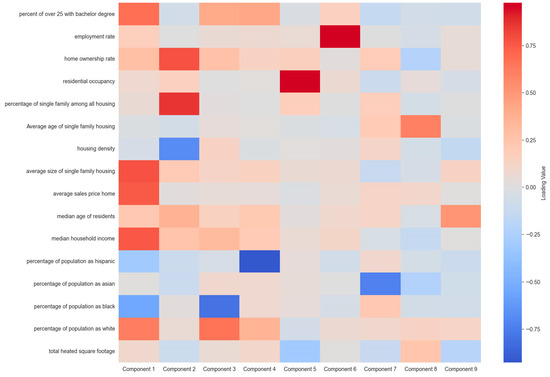
Figure A4.
Heatmap of rotated component loadings of socio-spatial variables.

Table A4.
The share of variance explained for each rotated component for socio-spatial variables.
Table A4.
The share of variance explained for each rotated component for socio-spatial variables.
| Component | Share of Variance |
|---|---|
| Component 1 | 0.19 |
| Component 2 | 0.13 |
| Component 3 | 0.09 |
| Component 4 | 0.08 |
| Component 5 | 0.06 |
| Component 6 | 0.06 |
| Component 7 | 0.05 |
| Component 8 | 0.03 |
| Component 9 | 0.02 |
| Total | 0.71 |
References
- Mara, F.; Cutini, V. The Environmental Approach to Security: A Historical-Theoretical Literature Review on Space and Crime. Plan. Theory Pract. 2024, 25, 525–547. [Google Scholar] [CrossRef]
- van Soomeren, P. Tackling crime and fear of crime through urban planning and Architectural Design. Crime Prev. Environ. Des. 2013, 3, 219–272. [Google Scholar]
- Ceccato, V. The Urban Fabric of Crime and Fear. In The Urban Fabric of Crime and Fear; Ceccato, V., Ed.; Springer: Dordrecht, The Netherlands, 2012; pp. 1–33. ISBN 978-94-007-4210-9. [Google Scholar]
- Bernasco, W.; Block, R. Robberies in Chicago: A Block-Level Analysis of the Influence of Crime Generators, Crime Attractors, and Offender Anchor Points. J. Res. Crime Delinq. 2011, 48, 33–57. [Google Scholar] [CrossRef]
- Brantingham, P.; Brantingham, P. Criminality of Place: Crime Generators and Crime Attractors. Eur. J. Crim. Policy Res. 1995, 3, 5–26. [Google Scholar] [CrossRef]
- Shalev, K. Strategies Property Offenders Use in Spatial Decision Making. Ph.D. Thesis, University of Liverpool, Liverpool, UK, 2004. Available online: https://livrepository.liverpool.ac.uk/3174839/1/408559.pdf (accessed on 25 November 2024).
- Van Daele, S.; Beken, T.V. Outbound offending: The journey to crime and crime sprees. J. Environ. Psychol. 2011, 31, 70–78. [Google Scholar] [CrossRef]
- Kim, Y.-A.; Hipp, J.R. Pathways: Examining Street Network Configurations, Structural Characteristics and Spatial Crime Patterns in Street Segments. J. Quant. Criminol. 2020, 36, 725–752. [Google Scholar] [CrossRef]
- Haider, M.; Iamtrakul, P. Theoretical Concepts of Crime and Practices in Urban Planning and Design Process for Safe Urban Life. Int. J. Build. Urban Inter. Landsc. Technol. 2018, 12, 7–24. [Google Scholar]
- Mao, Y.; Yin, L.; Zeng, M.; Ding, J.; Song, Y. Review of Empirical Studies on Relationship between Street Environment and Crime. J. Plan. Lit. 2021, 36, 187–202. [Google Scholar] [CrossRef]
- Summers, L.; Johnson, S.D. Does the Configuration of the Street Network Influence Where Outdoor Serious Violence Takes Place? Using Space Syntax to Test Crime Pattern Theory. J. Quant. Criminol. 2017, 33, 397–420. [Google Scholar] [CrossRef]
- Duffee, D.; McDowall, D.; Mazerolle, L.G.; Mastrofski, S.D. Measurement and Analysis of Crime and Justice: An Introductory Essay. Crim. JUSTICE 2000, 4, 1–31. Available online: https://nij.ojp.gov/library/publications/measurement-and-analysis-crime-and-justice-introductory-essay (accessed on 12 December 2024).
- Astengo, G. Urbanistica; Istituto Perla Collaborazione Culturale: Rome, Italy, 1971; Available online: https://webapps.unitn.it/Biblioteca/it/Web/EngibankFile/1953indice%2013.pdf (accessed on 18 October 2024).
- Cozens, P.; Love, T. A Review and Current Status of Crime Prevention through Environmental Design (CPTED). J. Plan. Lit. 2015, 30, 393–412. [Google Scholar] [CrossRef]
- Plucknett, T. Edward I and Criminal Law/by TFT Plucknett; Cambridge [Cambridgeshire] University Press: Cambridge, UK, 1960. [Google Scholar]
- Dyos, H.J. Urban Transformation: A Note on the Objects of Street Improvement in Regency and Early Victorian London. Int. Rev. Soc. Hist. 1957, 2, 259–265. [Google Scholar] [CrossRef]
- Tobias, J.J. Urban Crime in Victorian England; Schocken Books: New York, NY, USA, 1967. [Google Scholar]
- Fortunati, V. Le Città Utopiche tra Immaginazione e Storia. 2003. Available online: http://hdl.handle.net/10077/7135 (accessed on 15 December 2024).
- Beirne, P. Adolphe Quetelet and the Origins of Positivist Criminology. Am. J. Sociol. 1987, 92, 1140–1169. [Google Scholar] [CrossRef]
- Bellair, P. Social Disorganization Theory. In Oxford Research Encyclopedia of Criminology; Oxford University Press: Oxford, UK, 2017; ISBN 978-0-19-026407-9. Available online: https://oxfordre.com/criminology/display/10.1093/acrefore/9780190264079.001.0001/acrefore-9780190264079-e-253 (accessed on 2 September 2024).
- Gibson, V.L. Third Generation CPTED? Rethinking the Basis for Crime Prevention Strategies. Ph.D. Thesis, University of Northumbria, Newcastle, UK, 2016. Available online: https://www.proquest.com/docview/1864778307/abstract/31B5E90485D44DA2PQ/1 (accessed on 4 December 2024).
- Kornhauser, R.R. Social Sources of Delinquency: An Appraisal of Analytic Models. Ph.D. Thesis, The University of Chicago, Chicago, IL, USA, 1975. Available online: https://www.proquest.com/docview/302825154/citation/FBCA4F89FF60436CPQ/1 (accessed on 25 November 2024).
- Kubrin, C.E.; Wo, J.C. Social Disorganization Theory’s Greatest Challenge. In The Handbook of Criminological Theory; John Wiley & Sons, Ltd.: Hoboken, NJ, USA, 2015; pp. 121–136. ISBN 978-1-118-51244-9. [Google Scholar]
- Peck, J.H.; Leiber, M.J.; Beaudry-Cyr, M.; Toman, E.L. The Conditioning Effects of Race and Gender on the Juvenile Court Outcomes of Delinquent and “Neglected” Types of Offenders. Justice Q. 2016, 33, 1210–1236. [Google Scholar] [CrossRef]
- Dao, T.H.D.; Thill, J.-C. CrimeScape: Analysis of socio-spatial associations of urban residential motor vehicle theft. Soc. Sci. Res. 2022, 101, 102618. [Google Scholar] [CrossRef] [PubMed]
- Cozens, P.M. Urban Planning and Environmental Criminology: Towards a New Perspective for Safer Cities. Plan. Pract. Res. 2011, 26, 481–508. [Google Scholar] [CrossRef]
- Newman, O. Creating Defensible Space; DIANE Publishing: Darby, PA, USA, 1997; ISBN 978-0-7881-4528-5. [Google Scholar]
- Mayhew, P.; Clarke, R.V.G.; Sturman, A.; Hough, J.M. Crime as Opportunity; HM Stationery Office: London, UK, 1976; Volume 34, Available online: https://popcenter.asu.edu/sites/default/files/124-mayhew_et_al-crime_as_opportunity.pdf (accessed on 12 January 2025).
- Cohen, L.E.; Felson, M. Social Change and Crime Rate Trends: A Routine Activity Approach. Am. Sociol. Rev. 1979, 44, 588–608. [Google Scholar] [CrossRef]
- Wilson, J.Q.; Kelling, G. “Broken Windows” Critical Issues in Policing: Contemporary Readings. 1982. Available online: https://www.crimeconomics.com/s/BrokenWindows-AtlantaicMonthly-March82-xr78.pdf (accessed on 2 October 2024).
- Birks, D.; Davies, T. Street Network Structure and Crime Risk: An Agent-Based Investigation of the Encounter and Enclosure Hypotheses. Criminology 2017, 55, 900–937. [Google Scholar] [CrossRef]
- Beavon, D.J.; Brantingham, P.L.; Brantingham, P.J. The influence of street networks on the patterning of property offenses. Crime Prev. Stud. 1994, 2, 115–148. [Google Scholar]
- Hollis-Peel, M.E.; Welsh, B.C. What makes a guardian capable? A test of guardianship in action. Secur. J. 2014, 27, 320–337. [Google Scholar] [CrossRef]
- Ackerman, J.M.; Rossmo, D.K. How Far to Travel? A Multilevel Analysis of the Residence-to-Crime Distance. J. Quant. Criminol. 2015, 31, 237–262. [Google Scholar] [CrossRef]
- Baran, P.K.; Smith, W.R.; Toker, U. The space syntax and crime. In Proceedings of the 6th International Space Syntax Symposium, Istanbul, Turkey, 21–15 June 2007; Available online: http://spacesyntaxistanbul.itu.edu.tr/papers/shortpapers/119%20-%20Baran%20Smith%20Toker.pdf (accessed on 5 September 2024).
- Davies, T.; Johnson, S.D. Examining the Relationship Between Road Structure and Burglary Risk Via Quantitative Network Analysis. J. Quant. Criminol. 2015, 31, 481–507. [Google Scholar] [CrossRef]
- Davison, E.; Smith, W. Exploring accessibility versus opportunity crime factors. Sociation Today J. N. C. Sociol. Assoc. 2003, 1, 1–9. Available online: https://libres.uncg.edu/ir/asu/f/Davison_Beth_2003_Exploring_Accessibility.pdf (accessed on 8 December 2024).
- Frith, M.J.; Johnson, S.D.; Fry, H.M. Role of the Street Network in Burglars’ Spatial Decision-Making. Criminology 2017, 55, 344–376. [Google Scholar] [CrossRef]
- Johnson, S.D.; Bowers, K.J. Permeability and Burglary Risk: Are Cul-de-Sacs Safer? J. Quant. Criminol. 2010, 26, 89–111. [Google Scholar] [CrossRef]
- Nutter, J.B.; Bevis, C. Changing Street Layouts to Reduce Residential Burglary; NCJ Number 51937; Minnesota Crime Prevention Center: Minneapolis, MN, USA, 1977. Available online: https://www.ojp.gov/pdffiles1/Digitization/51937NCJRS.pdf (accessed on 5 December 2024).
- White, G.F. Neighborhood permeability and burglary rates. Justice Q. 1990, 7, 57–67. [Google Scholar] [CrossRef]
- Eck, J.E.; Weisburd, D. Crime places in crime theory. Crime Place Crime Prev. Stud. 2015, 4, 1–33. Available online: https://papers.ssrn.com/sol3/Delivery.cfm/SSRN_ID2629856_code2377032.pdf?abstractid=2629856&mirid=1 (accessed on 5 February 2025).
- Rengert, G.F.; Wasilchick, J. Suburban Burglary: A Tale of Two Suburbs; Charles C. Thomas: Springfield, IL, USA, 2000. Available online: https://www.ojp.gov/ncjrs/virtual-library/abstracts/suburban-burglary-tale-two-suburbs-second-edition (accessed on 12 July 2024).
- Taylor, R.B.; Harrell, A. Physical Environment and Crime; US Department of Justice: Washington, DC, USA, 1996. [Google Scholar]
- Groff, E.R.; Taylor, R.B.; Elesh, D.B.; McGovern, J.; Johnson, L. Permeability across a Metropolitan Area: Conceptualizing and Operationalizing a Macrolevel Crime Pattern Theory. Environ. Plan. A 2014, 46, 129–152. [Google Scholar] [CrossRef]
- Weisburd, D.; Zastrow, T.; Kuen, K.; Andresen, M.A. Crime concentrations at micro places: A review of the evidence. Aggress. Violent Behav. 2024, 78, 101979. [Google Scholar] [CrossRef]
- Kronkvist, K. Placing Perceptions of Unsafety: Examining Spatial Concentrations and Temporal Patterns of Unsafe Locations at Micro-Places. J. Quant. Criminol. 2024, 40, 191–213. [Google Scholar] [CrossRef]
- Nepomuceno, T.C.C.; Costa, A.P.C.S. Spatial visualization on patterns of disaggregate robberies. Oper. Res. 2019, 19, 857–886. [Google Scholar] [CrossRef]
- Weisburd, D.; Groff, E.R.; Yang, S.-M. The Criminology of Place: Street Segments and Our Understanding of the Crime Problem, 1st ed.; Oxford University Press: Oxford, UK, 2012; ISBN 978-0-19-992863-7. [Google Scholar]
- Pratt, T.C.; Cullen, F.T. Assessing Macro-Level Predictors and Theories of Crime: A Meta-Analysis. Crime Justice 2005, 32, 373–450. [Google Scholar] [CrossRef]
- Rosa, A.G.F.; de Miranda Mota, C.M.; de Figueiredo, C.J.J. A spatial multi-criteria decision analysis framework to reveal vulnerabilities of areas to incidences of street robberies. Appl. Geogr. 2023, 151, 102840. [Google Scholar] [CrossRef]
- Stucky, T.D.; Ottensmann, J.R. Land Use and Violent Crime. Criminology 2009, 47, 1223–1264. [Google Scholar] [CrossRef]
- Browning, C.R.; Byron, R.A.; Calder, C.A.; Krivo, L.J.; Kwan, M.-P.; Lee, J.-Y.; Peterson, R.D. Commercial Density, Residential Concentration, and Crime: Land Use Patterns and Violence in Neighborhood Context. J. Res. Crime Delinq. 2010, 47, 329–357. [Google Scholar] [CrossRef]
- Lima, R.A.; Taques, F.H.; Nepomuceno, T.C.C.; de Figueiredo, C.J.J.; Poleto, T.; de Carvalho, V.D.H. Simultaneous Causality and the Spatial Dynamics of Violent Crimes as a Factor in and Response to Police Patrolling. Urban Sci. 2024, 8, 132. [Google Scholar] [CrossRef]
- U.S. Census Bureau. Population Estimates, Demographic Characteristics, and Economic Data for Charlotte, North Carolina. 2023. Available online: https://www.census.gov/quickfacts/fact/table/charlottecitynorthcarolina/PST045223 (accessed on 10 July 2024).
- Boeing, G. Urban spatial order: Street network orientation, configuration, and entropy. Appl. Netw. Sci. 2019, 4, 67. [Google Scholar] [CrossRef]
- CMPD. 2023 Annual Report; Charlotte-Mecklenburg Police Department: Charlotte, NC, USA, 2023. Available online: https://www.charlottenc.gov/files/sharedassets/police/v/1/newsroom/article_documents/cmpd-eoy-website-reduced.pdf (accessed on 10 September 2024).
- Federal Bureau of Investigation. Offense Definitions; Federal Bureau of Investigation: Washington, DC, USA, 2019. Available online: https://ucr.fbi.gov/crime-in-the-u.s/2019/crime-in-the-u.s.-2019/topic-pages/offense-definitions (accessed on 24 September 2024).
- Mecklenburg County Quality of Life Explorer 2022. Available online: https://mcmap.org/qol/#58/ (accessed on 1 March 2024).
- Mecklenburg County Mecklenburg County Tax Parcels with CAMA Data. 2024. Available online: https://maps.mecknc.gov/opendata/metadata/Tax_Parcels_with_CAMA_Data.html (accessed on 26 March 2024).
- Barthélemy, M. Spatial networks. Phys. Rep. 2011, 499, 1–101. [Google Scholar] [CrossRef]
- Boeing, G. OSMnx: New methods for acquiring, constructing, analyzing, and visualizing complex street networks. Comput. Environ. Urban Syst. 2017, 65, 126–139. [Google Scholar] [CrossRef]
- Boeing, G.D. Methods and Measures for Analyzing Complex Street Networks and Urban Form. Ph.D. Thesis, University of California, Berkeley, CA, USA, 2017. Available online: https://www.proquest.com/docview/1924684815/abstract/4EE07EF9CC55445BPQ/1 (accessed on 22 December 2024).
- Borgatti, S.P. Centrality and network flow. Soc. Netw. 2005, 27, 55–71. [Google Scholar] [CrossRef]
- Newman, M.E.J. A measure of betweenness centrality based on random walks. Soc. Netw. 2005, 27, 39–54. [Google Scholar] [CrossRef]
- Parthasarathi, P.; Levinson, D.; Hochmair, H. Network Structure and Travel Time Perception. PLoS ONE 2013, 8, e77718. [Google Scholar] [CrossRef] [PubMed]
- Parthasarathi, P.; Levinson, D. Network structure and the journey to work: An intra-metropolitan analysis. Transp. Res. Part Policy Pract. 2018, 118, 292–304. [Google Scholar] [CrossRef]
- Wang, F.; Antipova, A.; Porta, S. Street centrality and land use intensity in Baton Rouge, Louisiana. J. Transp. Geogr. 2011, 19, 285–293. [Google Scholar] [CrossRef]
- Boeing, G. A multi-scale analysis of 27,000 urban street networks: Every US city, town, urbanized area, and Zillow neighborhood. Environ. Plan. B Urban Anal. City Sci. 2020, 47, 590–608. [Google Scholar] [CrossRef]
- Bielik, M.; König, R.; Schneider, S.; Varoudis, T. Measuring the Impact of Street Network Configuration on the Accessibility to People and Walking Attractors. Netw. Spat. Econ. 2018, 18, 1–20. [Google Scholar] [CrossRef]
- Li, Y.; Shang, Y.; Yang, Y. Clustering coefficients of large networks. Inf. Sci. 2017, 382–383, 350–358. [Google Scholar] [CrossRef]
- Wang, Y.; Ghumare, E.; Vandenberghe, R.; Dupont, P. Comparison of Different Generalizations of Clustering Coefficient and Local Efficiency for Weighted Undirected Graphs. Neural Comput. 2017, 29, 313–331. [Google Scholar] [CrossRef]
- Labi, S.; Faiz, A.; Saeed, T.U.; Alabi, B.N.T.; Woldemariam, W. Connectivity, Accessibility, and Mobility Relationships in the Context of Low-Volume Road Networks. Transp. Res. Rec. 2019, 2673, 717–727. [Google Scholar] [CrossRef]
- Brandes, U. A faster algorithm for betweenness centrality. J. Math. Sociol. 2001, 25, 163–177. [Google Scholar] [CrossRef]
- Bergamini, E.; Crescenzi, P.; D’angelo, G.; Meyerhenke, H.; Severini, L.; Velaj, Y. Improving the Betweenness Centrality of a Node by Adding Links. ACM J. Exp. Algorithmics 2018, 23, 1–32. [Google Scholar] [CrossRef]
- Crucitti, P.; Latora, V.; Porta, S. Centrality in networks of urban streets. Chaos Interdiscip. J. Nonlinear Sci. 2006, 16, 015113. [Google Scholar] [CrossRef]
- Chen, H.-H.; Dietrich, U. Normalized closeness centrality of urban networks: Impact of the location of the catchment area and evaluation based on an idealized network. Appl. Netw. Sci. 2023, 8, 60. [Google Scholar] [CrossRef]
- Bowater, D.; Stefanakis, E. Extending the Adapted PageRank Algorithm centrality model for urban street networks using non-local random walks. Appl. Math. Comput. 2023, 446, 127888. [Google Scholar] [CrossRef]
- Batty, M.; Longley, P. Fractal Cities: A Geometry of Form and Function, 1st ed.; Academic Press: London, UK, 1994; ISBN 978-0-12-455570-9. [Google Scholar]
- Kansky, K.J. Structure of Transportation Networks: Relationships Between Network Geometry and Regional Characteristics; University of Chicago: Chicago, IL, USA, 1963. [Google Scholar]
- Watts, D.J.; Strogatz, S.H. Collective dynamics of ‘small-world’ networks. Nature 1998, 393, 440–442. [Google Scholar] [CrossRef] [PubMed]
- Granovetter, M.S. The Strength of Weak Ties. Am. J. Sociol. 1973, 78, 1360–1380. [Google Scholar] [CrossRef]
- Freeman, L.C. A Set of Measures of Centrality Based on Betweenness. Sociometry 1977, 40, 35–41. [Google Scholar] [CrossRef]
- Bavelas, A. Communication Patterns in Task-Oriented Groups. J. Acoust. Soc. Am. 1950, 22, 725–730. [Google Scholar] [CrossRef]
- Page, L. The PageRank Citation Ranking: Bringing Order to the Web; Technical Report; Stanford infolab: Stanford, CA, USA, 1998. [Google Scholar]
- Mecklenburg County Street Centerline in Mecklenburg County 2023. Available online: https://maps.mecknc.gov/opendata/metadata/Street_Centerline.html (accessed on 8 May 2025).
- Kadar, C.; Feuerriegel, S.; Noulas, A.; Mascolo, C. Leveraging Mobility Flows from Location Technology Platforms to Test Crime Pattern Theory in Large Cities. arXiv 2020, arXiv:2004.08263. [Google Scholar] [CrossRef]
- O’Leary, M. Modeling Criminal Distance Decay. Cityscape 2011, 13, 161–198. [Google Scholar]
- Rossmo, D.K.; Wheeler, A. The Journey-to-Crime Buffer Zone: Measurement Issues and Methodological Challenges. CrimRxiv 2024, 95, 102272. [Google Scholar] [CrossRef]
- Babaey, V.; Ravindran, A. GenSQLi: A Generative Artificial Intelligence Framework for Automatically Securing Web Application Firewalls Against Structured Query Language Injection Attacks. Future Internet 2025, 17, 8. [Google Scholar] [CrossRef]
- Fan, J.; Sun, Q.; Zhou, W.-X.; Zhu, Z. Principal component analysis for big data. arXiv 2018, arXiv:1801.01602. [Google Scholar] [CrossRef]
- Janicijevic, S.; Mizdrakovic, V.; Kljajić, M. Principal Component Analysis in Financial Data Science. In Advances in Principal Component Analysis; IntechOpen: London, UK, 2022; ISBN 978-1-80355-765-6. [Google Scholar] [CrossRef]
- Mavungu, M. Computation of financial risk using principal component analysis. Algorithmic Financ. 2023, 10, 1–20. [Google Scholar] [CrossRef]
- Cossu, G.; Agus, M.; Atzori, L.; Aviles Gonzales, C.I.; Minerba, L.; Ferreli, C.; Puxeddu, R.; Orrù, G.; Scano, A.; Romano, F.; et al. Principal Component Analysis of the Social and Behavioral Rhythms Scale in elderly. J. Public Health Res. 2022, 11, jphr-2021. [Google Scholar] [CrossRef] [PubMed]
- Magyar, Z.B. What Makes Party Systems Different? A Principal Component Analysis of 17 Advanced Democracies 1970–2013. Polit. Anal. 2022, 30, 250–268. [Google Scholar] [CrossRef]
- U.S. Census Bureau. American Community Survey 2015–2019, 5-Year Estimates; U.S Census Bureau: Washington, DC, USA, 2019.
- Minnesota Population Center. National Historical Geographic Information System. Available online: https://www.nhgis.org (accessed on 26 June 2024).
- U.S. Census Bureau. Decennial Census: Summary File 1, QT-P3. Available online: https://www.census.gov/programs-surveys/decennial-census/about/rdo/summary-files.2010.html (accessed on 20 June 2024).
- Gelman, A. Data Analysis Using Regression and Multilevel/Hierarchical Models; Cambridge University Press: Cambridge, UK, 2007; Available online: https://www.cambridge.org/highereducation/books/data-analysis-using-regression-and-multilevel-hierarchical-models/32A29531C7FD730C3A68951A17C9D983#overview (accessed on 10 November 2024).
- Venables, W.N.; Ripley, B.D. Modern Applied Statistics with S; Springer Science & Business Media: Berlin/Heidelberg, Germany, 2003; ISBN 978-0-387-95457-8. [Google Scholar]
- Lindgren, F.; Rue, H. Bayesian Spatial Modelling with R-INLA. J. Stat. Softw. 2015, 63, 1–25. Available online: http://www.jstatsoft.org/v63/i19 (accessed on 20 May 2024). [CrossRef]
- Fotheringham, A.S.; Brunsdon, C.; Charlton, M.E. Geographically Weighted Regression: The Analysis of Spatially Varying Relationships; Wiley: Hoboken, NJ, USA, 2002; Available online: https://www.wiley.com/en-us/Geographically+Weighted+Regression%3A+The+Analysis+of+Spatially+Varying+Relationships+-p-9780471496168 (accessed on 1 June 2024).
- de Vries, I.; Davies, T. Understanding the role of street network configurations in the placement of illegitimately operating facilities. Criminology 2024, 62, 412–453. [Google Scholar] [CrossRef]
- Hatten, D.; Piza, E.L. When Crime Moves Where Does It Go? Analyzing the Spatial Correlates of Robbery Incidents Displaced by a Place-based Policing Intervention. J. Res. Crime Delinq. 2022, 59, 128–162. [Google Scholar] [CrossRef]
- Cozens, P.; Love, T. Manipulating Permeability as a Process for Controlling Crime: Balancing Security and Sustainability in Local Contexts. Built Environ. 2009, 35, 346–365. [Google Scholar] [CrossRef]
- Jamalishahni, T.; Davern, M.; Villanueva, K.; Turrell, G.; Foster, S. The contribution of objective and perceived crime to neighbourhood socio-economic inequity in loneliness. Health Place 2024, 85, 103165. [Google Scholar] [CrossRef]
- O’Sullivan, D. Too much of the wrong kind of data. Implications for the practice of micro-scale spatial modeling. In Spatially Integrated Social Science; Oxford University Press: Oxford, UK, 2004; pp. 95–108. [Google Scholar]
- Hipp, J.R. Block, Tract, and Levels of Aggregation: Neighborhood Structure and Crime and Disorder as a Case in Point. Am. Sociol. Rev. 2007, 72, 659–680. [Google Scholar] [CrossRef]
- Taylor, R.B. Community Criminology: Fundamentals of Spatial and Temporal Scaling, Ecological Indicators, and Selectivity Bias; New York University Press: New York, NY, USA, 2015; ISBN 978-0-8147-2549-8. [Google Scholar]
- Dao, T.H.D.; Thill, J.-C. The SpatialARMED Framework: Handling Complex Spatial Components in Spatial Association Rule Mining. Geogr. Anal. 2016, 48, 248–274. [Google Scholar] [CrossRef]
- Dong, Z.; Mateu, J.; Xie, Y. Spatio-Temporal-Network Point Processes for Modeling Crime Events with Landmarks. arXiv 2024, arXiv:2409.10882. [Google Scholar] [CrossRef]
- Shiode, S.; Shiode, N. Network-based space-time search-window technique for hotspot detection of street-level crime incidents. Int. J. Geogr. Inf. Sci. 2013, 27, 866–882. [Google Scholar] [CrossRef]
- Lee, S.; Chang, W.; Mateu, J.; Lee, H.; Park, J. A Spatio-Temporal Dirichlet Process Mixture Model on Linear Networks for Crime Data. arXiv 2025, arXiv:2501.08673. [Google Scholar] [CrossRef]
Disclaimer/Publisher’s Note: The statements, opinions and data contained in all publications are solely those of the individual author(s) and contributor(s) and not of MDPI and/or the editor(s). MDPI and/or the editor(s) disclaim responsibility for any injury to people or property resulting from any ideas, methods, instructions or products referred to in the content. |
© 2025 by the authors. Published by MDPI on behalf of the International Society for Photogrammetry and Remote Sensing. Licensee MDPI, Basel, Switzerland. This article is an open access article distributed under the terms and conditions of the Creative Commons Attribution (CC BY) license (https://creativecommons.org/licenses/by/4.0/).